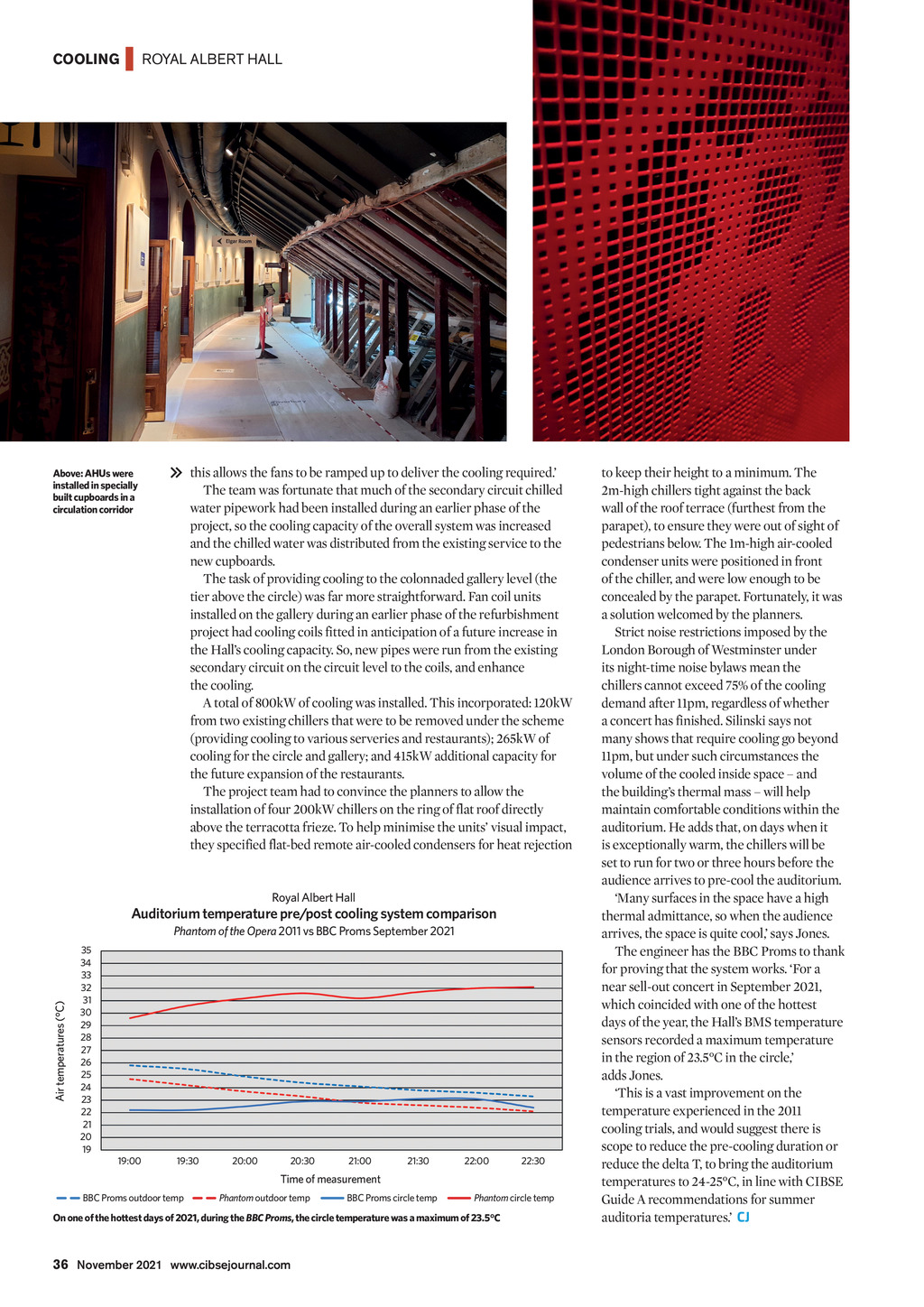




COOLING | ROYAL ALBERT HALL this allows the fans to be ramped up to deliver the cooling required. The team was fortunate that much of the secondary circuit chilled water pipework had been installed during an earlier phase of the project, so the cooling capacity of the overall system was increased and the chilled water was distributed from the existing service to the new cupboards. The task of providing cooling to the colonnaded gallery level (the tier above the circle) was far more straightforward. Fan coil units installed on the gallery during an earlier phase of the refurbishment project had cooling coils fitted in anticipation of a future increase in the Halls cooling capacity. So, new pipes were run from the existing secondary circuit on the circuit level to the coils, and enhance the cooling. A total of 800kW of cooling was installed. This incorporated: 120kW from two existing chillers that were to be removed under the scheme (providing cooling to various serveries and restaurants); 265kW of cooling for the circle and gallery; and 415kW additional capacity for the future expansion of the restaurants. The project team had to convince the planners to allow the installation of four 200kW chillers on the ring of flat roof directly above the terracotta frieze. To help minimise the units visual impact, they specified flat-bed remote air-cooled condensers for heat rejection Above: AHUs were installed in specially built cupboards in a circulation corridor Royal Albert Hall Auditorium temperature pre/post cooling system comparison Air temperatures (C) Phantom of the Opera 2011 vs BBC Proms September 2021 35 34 33 32 31 30 29 28 27 26 25 24 23 22 21 20 19 19:00 19:30 20:00 20:30 21:00 21:30 22:00 22:30 Time of measurement BBC Proms outdoor temp Phantom outdoor temp BBC Proms circle temp Phantom circle temp On one of the hottest days of 2021, during the BBC Proms, the circle temperature was a maximum of 23.5C to keep their height to a minimum. The 2m-high chillers tight against the back wall of the roof terrace (furthest from the parapet), to ensure they were out of sight of pedestrians below. The 1m-high air-cooled condenser units were positioned in front of the chiller, and were low enough to be concealed by the parapet. Fortunately, it was a solution welcomed by the planners. Strict noise restrictions imposed by the London Borough of Westminster under its night-time noise bylaws mean the chillers cannot exceed 75% of the cooling demand after 11pm, regardless of whether a concert has finished. Silinski says not many shows that require cooling go beyond 11pm, but under such circumstances the volume of the cooled inside space and the buildings thermal mass will help maintain comfortable conditions within the auditorium. He adds that, on days when it is exceptionally warm, the chillers will be set to run for two or three hours before the audience arrives to pre-cool the auditorium. Many surfaces in the space have a high thermal admittance, so when the audience arrives, the space is quite cool, says Jones. The engineer has the BBC Proms to thank for proving that the system works. For a near sell-out concert in September 2021, which coincided with one of the hottest days of the year, the Halls BMS temperature sensors recorded a maximum temperature in the region of 23.5C in the circle, adds Jones. This is a vast improvement on the temperature experienced in the 2011 cooling trials, and would suggest there is scope to reduce the pre-cooling duration or reduce the delta T, to bring the auditorium temperatures to 24-25C, in line with CIBSE Guide A recommendations for summer auditoria temperatures. CJ 36 November 2021 www.cibsejournal.com CIBSE Nov21 pp32-34, 36 Royal Albert Hall.indd 36 22/10/2021 18:12